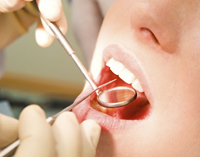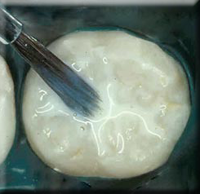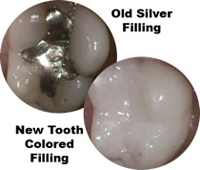General Dentistry
Cleaning and Prevention
 We work with you to devise a program that will keep your natural teeth and the supporting structures clean and healthy, to prevent diseases or conditions from starting, progressing, or returning.
We work with you to devise a program that will keep your natural teeth and the supporting structures clean and healthy, to prevent diseases or conditions from starting, progressing, or returning.
The core of this program starts with you, at home, maintaining a balanced diet and following good oral hygiene practices. Then, when you come to Dental Artistry of the Main Line, Dr. Sharma and the hygienist work hard to ensure you maintain excellent oral health.
Additional features of the best preventive program are routine dental visits for cleaning and x-rays. We may also recommend fluoride treatments or sealants to help protect your teeth and keep them in tip-top shape.
Following the program we devise with you will avoid problems that cost money, time, and teeth, and help you keep that gorgeous smile.
Dental Sealants
 Most dental decay (up to 75%!) starts in the chewing surfaces of the molars and premolars, and especially in deep grooves (aka pits and fissures) of the teeth. That’s because these areas are more difficult to clean, and can harbor bacteria despite our best efforts.
Most dental decay (up to 75%!) starts in the chewing surfaces of the molars and premolars, and especially in deep grooves (aka pits and fissures) of the teeth. That’s because these areas are more difficult to clean, and can harbor bacteria despite our best efforts.
Our weapon against decay in these conditions is sealants. This is a thin plastic coating applied to the tooth surface. It seals the grooves, making the surface smooth and easy to clean. We check them for wear and chipping during your routine exams, which means they can protect your teeth for years.
Tooth-Colored White Fillings
 Silver-mercury amalgam fillings are the common material for fixing cavities, but we offer a better choice. White bonded fillings (also known as composites) allow you to avoid metal or a dark spot in a visible tooth, and can increase the longevity of your filling. Since they bond very tightly, without the temperature effects of metal fillings, your chance of future decay is smaller. They’re also natural looking and match the color of your teeth, so no one can tell they’re there.
Silver-mercury amalgam fillings are the common material for fixing cavities, but we offer a better choice. White bonded fillings (also known as composites) allow you to avoid metal or a dark spot in a visible tooth, and can increase the longevity of your filling. Since they bond very tightly, without the temperature effects of metal fillings, your chance of future decay is smaller. They’re also natural looking and match the color of your teeth, so no one can tell they’re there.
Composite fillings work for chipped teeth, filling spaces between teeth, replacing decayed sections, fixing cracks, and repairing worn areas.
Root Canals & Root Canal Therapy
Root canal therapy is needed when the nerve of a tooth is affected by decay or infection. In order to save the tooth, the pulp (living tissue inside the tooth), nerves, bacteria, and any decay are removed and the resulting space is filled with special medicated dental materials which restore the tooth to its full function. Teeth needing root canal therapy are not always symptomatic.
Having root canal therapy on a tooth is the treatment of choice to save a tooth that otherwise would get infected, swell and lead to severe complications. Many patients believe that removing a tooth that has problems is the best solution, but extracting (pulling) a tooth will ultimately be more costly and cause significant problems for adjacent teeth. Root canal treatment is highly successful and usually lasts a lifetime, although occasionally a tooth may have to be re-treated due to new infections.
Headache Treatments (TMJ / TMD Therapy)
 There are two temporomandibular joints (TMJ) which allow your jaw to open, close, and move side to side. If your jaw joints are misaligned, this may cause jaw clicking, teeth grinding, facial pain, and discomfort in your temple, ear, neck, and shoulders. Other common issues or problems may include headaches or migraines, as well as earaches which stem from TMJ disorder.
There are two temporomandibular joints (TMJ) which allow your jaw to open, close, and move side to side. If your jaw joints are misaligned, this may cause jaw clicking, teeth grinding, facial pain, and discomfort in your temple, ear, neck, and shoulders. Other common issues or problems may include headaches or migraines, as well as earaches which stem from TMJ disorder.
There are several types of oral appliances available, offering non-surgical therapies, which will assist in correcting the symptoms of TMJ disorder.
Several symptoms could include:
- Jaw Pain
- Headaches
- Noise coming from the joint, including clicking or popping
- Pain in the ear
- Pain in the face
- Ringing in the ears (tinnitus)
- Pain or spasm in the neck or shoulder muscles
- Shortened teeth from grinding
- Inability to open very wide
- A change in your bite
If you are suffering from headaches, neck or shoulder pain, or any of the other above mentioned symptoms, contact our office to schedule a consultation with Dr. Sharma to find more about TMJ therapy.
Sleep Apnea & Snoring Alternative Treatment
 According to the International Classification for Sleep Disorders, habitual snoring has been found in about 24 percent of adult women and 40 percent of adult men. Based on additional information from the American Academy of Dental Sleep Medicine (AADSM), at least 12-18 million adults in the U.S. have obstructive sleep apnea, and up to 50 percent of those sleep apnea patients do not comply with or tolerate CPAP treatment. The research suggests that average CPAP use tends to fall between 3.0 and 5.0 hours per night.
According to the International Classification for Sleep Disorders, habitual snoring has been found in about 24 percent of adult women and 40 percent of adult men. Based on additional information from the American Academy of Dental Sleep Medicine (AADSM), at least 12-18 million adults in the U.S. have obstructive sleep apnea, and up to 50 percent of those sleep apnea patients do not comply with or tolerate CPAP treatment. The research suggests that average CPAP use tends to fall between 3.0 and 5.0 hours per night.
Compliance with oral appliance therapy has been shown, using patient diaries validated by covert monitoring, to be as high as 75 percent of patients using the appliance all night seven nights a week. Oral appliance therapy often can equal CPAP in effectiveness and offer a higher patient compliance than CPAP.
Patients with loud snoring and diagnosed sleep apnea suffers with difficulty tolerating CPAP should contact Dr. Sharma at 610-254-9575 to schedule a consultation appointment. Dr. Sharma works closely with sleep physicians to treat snoring and obstructive sleep apnea.

